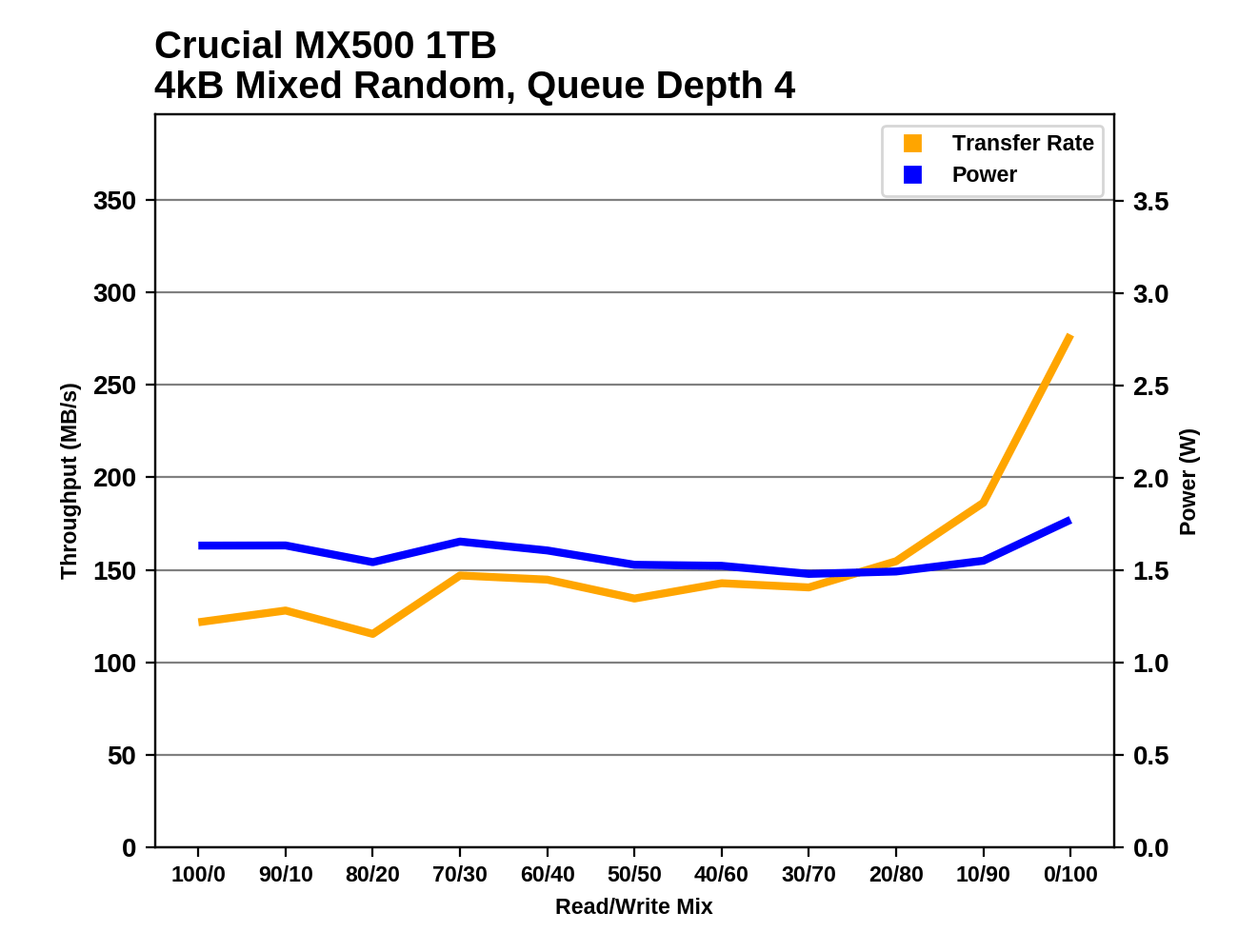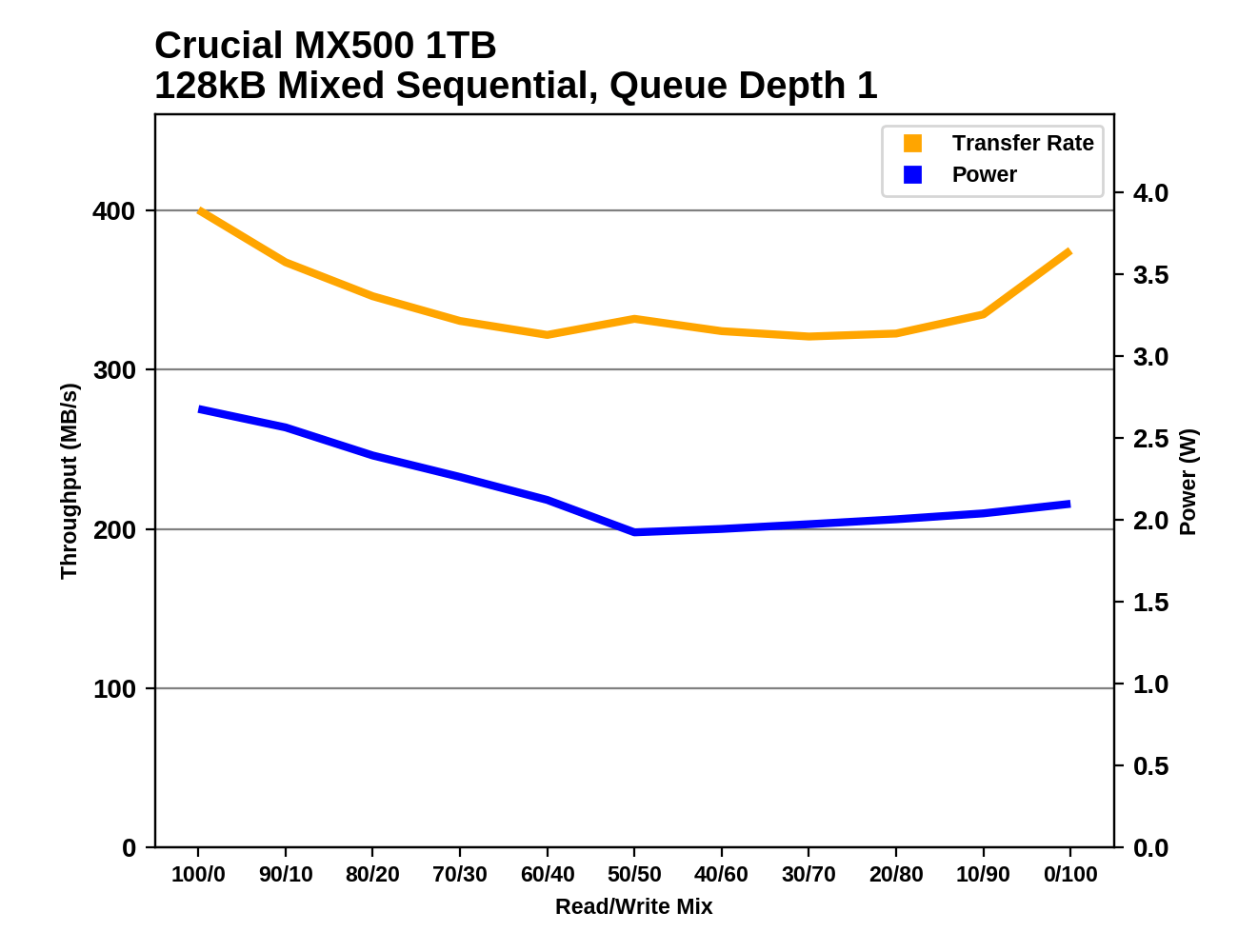The Crucial MX500 1TB SSD Review: Breaking The SATA Mold
by Billy Tallis on December 19, 2017 8:00 AM ESTMixed Random Performance
Our test of mixed random reads and writes covers mixes varying from pure reads to pure writes at 10% increments. Each mix is tested for up to 1 minute or 32GB of data transferred. The test is conducted with a queue depth of 4, and is limited to a 64GB span of the drive. In between each mix, the drive is given idle time of up to one minute so that the overall duty cycle is 50%.

The mixed random I/O performance of the Crucial MX500 is slightly slower than both the MX300 and the Intel 545s, but still above average for mainstream SATA SSDs. The 64L 3D TLC drives from Toshiba and Western Digital/SanDisk are significantly slower, and the Samsung 850 PRO and 850 EVO are still the fastest for this test.

The Crucial MX300 and Intel 545s are tied for first place for power efficiency on this test, with the MX500 coming in third place and well ahead of the other mainstream SATA drives.
 |
|||||||||
The Crucial MX500's performance during this test is a bit unsteady but generally good during the first half when the workload is more read-heavy. The MX500's speed picks up significantly when the workload becomes very write-heavy, but it take too long to start speeding up; other drives like the Samsung 850 PRO and EVO are steadily accelerating with increasing proportion of writes, starting fairly early in the test.
Mixed Sequential Performance
Our test of mixed sequential reads and writes differs from the mixed random I/O test by performing 128kB sequential accesses rather than 4kB accesses at random locations, and the sequential test is conducted at queue depth 1. The range of mixes tested is the same, and the timing and limits on data transfers are also the same as above.

The Samsung 850 PRO and EVO are the fastest SATA drives on the mixed sequential I/O test, and the Crucial MX500 falls into the second tier of drives, along with the other mainstream 64L 3D TLC drives and the MX300.

The Toshiba TR200 and OCZ VX500 score highest on power efficiency for the mixed sequential I/O test because they include little or no DRAM. The MX500 scores reasonably well overall but worse than the MX300 and the Intel 545s.
 |
|||||||||
The Crucial MX500 performs well in the early, read-heavy phases of the test but performance drops toward the middle and only recovers slightly at the end of the test. The minimum performance level across the entire test is quite high, but the fastest drives spend much less time performing at or near their minimum.










90 Comments
View All Comments
StrangerGuy - Tuesday, December 19, 2017 - link
Hey let's pay >3x/GB for SLC so we can have extra drive endurance where TLC already doesn't matter for 99.999% of the target market, of course he's the smart one and rest of us are teh dumbs.10TB written over 3.5 years on my M550 1TB, yup can't wait for the drive to finally die in 300 years if it was *only* 1000 writes/bit TLC so I can buy a new one. Because TLC endurance sux amirite?
PeachNCream - Tuesday, December 19, 2017 - link
TLC is pretty good these days compared to planar MLC from 2012. You probably wouldn't have anything to worry about since a drive like the MX500 would be obsolete before endurance becomes a problem. But if you're worried, there's the BX300 that's still for sale like MajGenRelativity suggested. Mushkin was also selling a 3D MLC drive, the Reactor Armor3D that was released in January-ish of this year. They have a 1TB model available and it uses the same Silicon Motion SM2258 controller so you'd probably see similar performance.https://www.anandtech.com/show/11035/mushkin-launc...
ddrіver - Tuesday, December 19, 2017 - link
BS. This study proved SLC and MLC aren't actually meaningfully different. By inference TLC is good enough for almost anything. If you're the kind of person who can't do with TLC it's either overstating your usage scenarios or you're in the NAND destruction business.https://www.usenix.org/conference/fast16/technical...
mode_13h - Tuesday, December 19, 2017 - link
I wouldn't get so hung up on # of bits per cell. What matters is performance, write endurance, and (for some use cases) power-off data retention.mode_13h - Tuesday, December 19, 2017 - link
I'm really impressed with the QD1 random read performance of this drive. I didn't think you could achieve so many QD1 IOPS with SATA, or else Samsung probably would've done it.DoveOfTheSouth - Wednesday, December 20, 2017 - link
The QD1 results are impressive in the tables but the charts seem to show lower figures (QD1 read: 44.7 v c. 35; write 164.2 v c. 146). Which is correct?StrangerGuy - Tuesday, December 19, 2017 - link
The only thing that really matters is the 4K QD1 benchmark and that was extremely impressive for the asking price.shatteredx - Thursday, January 11, 2018 - link
Agreed. MX500 hard to beat for the price now.LordConrad - Wednesday, December 20, 2017 - link
"With the MX500 arriving at $259.99 for the same capacity but with a longer warranty..."The Samsung 850 EVO and Crucial MX500 both have a 5-year warranty.
diceman2037 - Thursday, September 2, 2021 - link
Unfortuantely, what this review couldn't account for was these SSDs have a serious defect where uptimes correlate to significant increases of write amplification in comparison to their older mx300 siblings and not fit for use as an OS drive.https://forums.tomshardware.com/threads/crucial-mx...